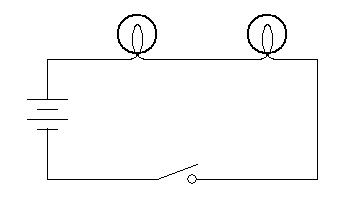This person invented the battery in 1800.
Alessandro Volta
What is an example of renewable energy?
What is electricity?
The flow of electrical charges (a result of the movement of electrons)
What is a complete circuit?
An unbroken pathway where electrons can flow in a complete circle. Electrical current flows from the battery, to the light, and back to the battery.
What is the safety tip that talks about water?
Never mix water and electricity.
This person published the first book dealing with magnetism.
William Gilbert
What is an example of non-renewable energy?
Coal, Oil or Gas, or Nuclear Energy.
True or False: a positive charge is formed when electrons are removed from a material, and a negative charge forms when electrons are added to a material.
TRUE
What does this symbol represent?
A battery.
What is the safety tip that talks about transformers and substations?
Stay away from transformers and substations.
This person developed the understanding of how voltage, resistance, and current are related and stated this relationship in his Law.
True or False: a battery works by converting stored chemical energy into electrical energy, which is released when the battery is in use.
TRUE
True or False: Poor conductors let electrons move freely and allow energy to pass through.
FALSE (Good conductors)
What is this type of circuit called?
Parallel circuit (incomplete/open)
What is the safety tip that talks about powerlines?
Stay away from powerlines.
This person worked with electrostatic devices and noted the influence that static electricity had on a frog's leg. This observation led to the discovery of the electric battery.
Dr. Luigi Galvani
How is electricity transformed into light energy?
When a light switch is turned on, it creates a complete circuit. Electricity is able to flow through the lightbulb and make it glow, creating light energy.
Static electricity or electricity at rest.
Explain why short circuits are dangerous.
Short circuits are dangerous because they can cause damage to electrical components, lead to fires, ruin batteries, and pose a risk of electrical shock or injury.
What is the safety tip that talks about outlets?
Don't put too many plugs into one outlet.
This person established a theoretical framework for the nature of electricity and static charge. (he called the charges that were produced positive and negative)
Benjamin Franklin
Name the 9 types of energy.
1. Gravitational
2. Elastic
3. Chemical
4. Electrical
5. Heat
6. Light
7. Sound
8. Potential
9. Kinetic
List 2 conductors and 2 insulators.
Conductors: Metals, Glass, Water, Humans
Insulators: Rubber, Plastic, Cotton, Wool, Wood, Paper
What would happen to the lightbulbs in this circuit if one were to burn out?

The circuit will be incomplete and the other lightbulb would go out.
What is the safety tip that talks about outlets and metal objects?
Never stick metal objects into an outlet or anything running on electricity.